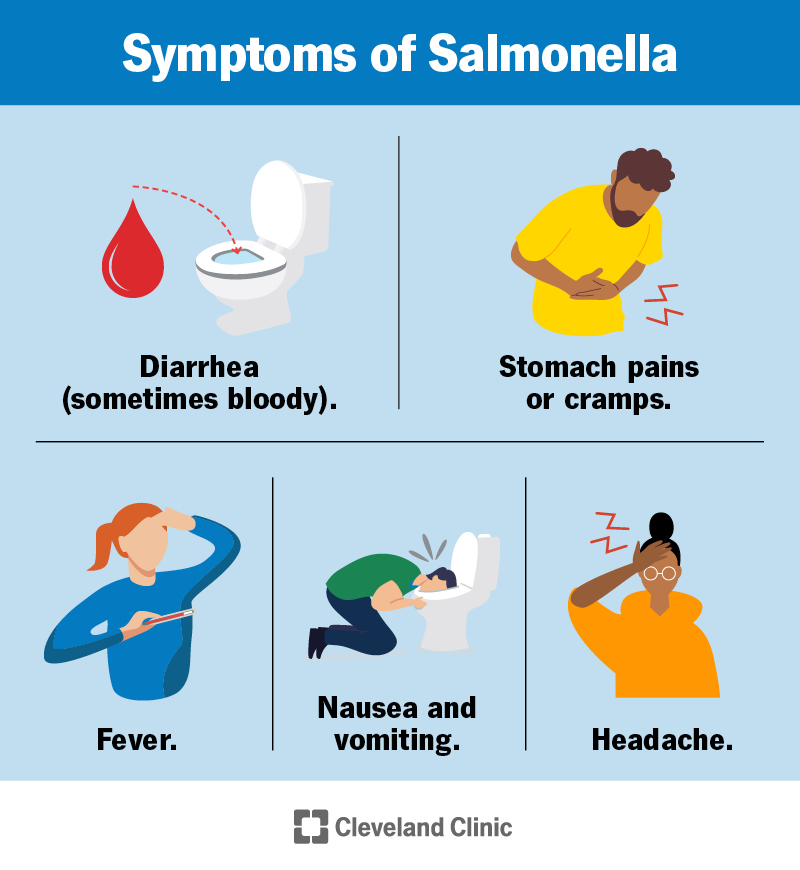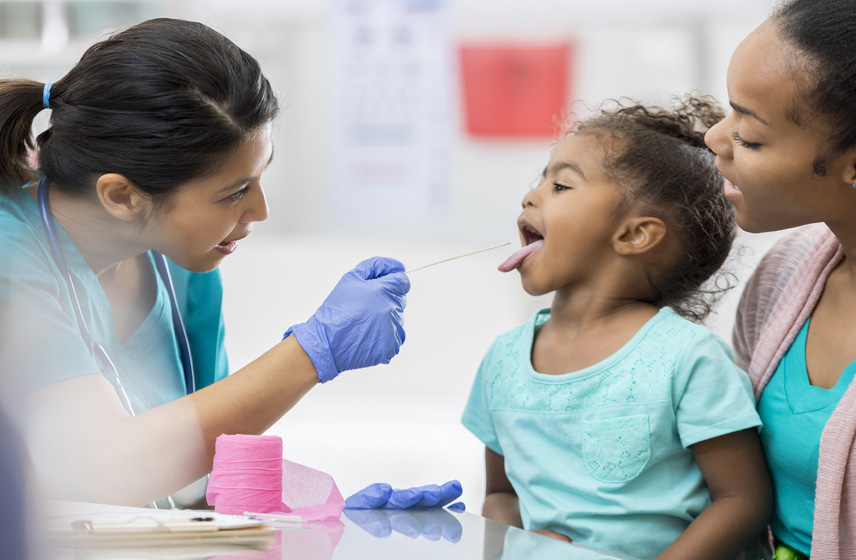Salmonella, or salmonellosis, is an infection with Salmonella bacteria that causes diarrhea, fever and stomach pains. Salmonella usually goes away on its own in a few days. You should drink plenty of fluids to prevent dehydration. You can reduce your risk of salmonella with safe food handling habits and by washing your hands after touching animals.
Advertisement
Cleveland Clinic is a non-profit academic medical center. Advertising on our site helps support our mission. We do not endorse non-Cleveland Clinic products or services. Policy

“Salmonella” is what we commonly call it when you get sick with diarrhea and stomach pains from Salmonella bacteria (gastroenteritis). It’s the most common form of bacterial food poisoning in the U.S.
Advertisement
Cleveland Clinic is a non-profit academic medical center. Advertising on our site helps support our mission. We do not endorse non-Cleveland Clinic products or services. Policy
It’s also called salmonellosis, to tell it apart from other illnesses you can get from different forms of Salmonella bacteria, like typhoid fever.
When you get salmonella, it means enough bacteria have gotten past your stomach acid and immune system to make you sick. Salmonella bacteria invade and destroy the cells that line your intestines. This makes it hard for your body to absorb water, which can give you stomach cramps. The water leaves your body in the form of diarrhea.
Anyone can get salmonella, but you might be at higher risk for infection or serious illness depending on your age, your living conditions and certain illnesses and medications.
You’re at an increased risk of getting salmonella if you:
You’re at higher risk for serious illness from a Salmonella infection if you:
Advertisement
Salmonella is one of the most common forms of food poisoning. Over a million people in the U.S. alone get salmonella every year and 26,500 are hospitalized. There are about 420 deaths due to salmonella every year in the U.S.
Many kinds of food have caused salmonella outbreaks, including peanut butter, packaged meats, frozen food and produce. Salmonella outbreaks from animals include pet turtles, lizards, chickens, hedgehogs and guinea pigs.
Symptoms of salmonella appear anywhere from a few hours to a few days after exposure to Salmonella bacteria. Symptoms of salmonella affect your stomach and intestines (GI tract) and include:
You may have some or all these symptoms.
No, you don’t always throw up when you have Salmonella poisoning. The most common symptoms are diarrhea and fever, though you do sometimes throw up.
When you have a salmonella, your poop is usually runny and you may have to go a lot. It may have blood in it. Call or visit your healthcare provider if you have blood in your poop.
Salmonella poisoning is caused by the bacteria Salmonella. When more Salmonella bacteria get into your body than it can destroy, you get an infection that causes fever, diarrhea and other stomach (gastrointestinal) issues.
Salmonella bacteria live in the guts of people and animals, but the things we eat, drink and touch can also be contaminated, including:
The most common way to get salmonella is from undercooked food or improper food prep, for instance:
You can also get salmonella from animals and people who are infected with Salmonella bacteria. You can get Salmonella bacteria on your hands when you touch an animal, then transfer it to your mouth. Almost any animal can have a Salmonella infection or carry Salmonella bacteria on its fur, feathers, scales or skin. This includes:
Advertisement
Almost any uncooked foods could be contaminated with Salmonella bacteria, but most people get sick from uncooked or undercooked poultry or eggs.
No, Salmonella bacteria doesn’t have a smell. Food contaminated with Salmonella bacteria usually smells and looks normal.
Yes, salmonella is contagious — you can get a Salmonella infection from another person or even your pet. If you don’t wash your hands after going to the bathroom or while you are sick, you can contaminate surfaces and foods and spread Salmonella to other people.
Salmonella is diagnosed with a test of your stool (poop), blood or other sample. Your healthcare provider will give you a physical exam and ask you about your symptoms and health history.
Advertisement
You usually don’t treat salmonella with medication. If you’re severely ill or at high risk for complications, your healthcare provider will treat you with antibiotics. If you have severe diarrhea, you may need to be hospitalized.
You should drink plenty of fluids. Your provider may give you IV fluids if you’re dehydrated.
If you need antibiotics for a Salmonella infection, your healthcare provider might prescribe:
The most important way to manage the symptoms of salmonella is to drink plenty of fluids to prevent dehydration. Fluids that help you stay hydrated include:
For adults, over-the-counter medications like loperamide (Imodium) and bismuth subsalicylate (Pepto-Bismol, Kaopectate) can help stop diarrhea. Don’t give diarrhea medications to children or infants without talking to your pediatrician.
Salmonella usually goes away on its own, though you may have to go through a few days of symptoms first. Make sure to drink plenty of fluids so you don’t get dehydrated.
Salmonella is usually self-limiting, meaning it goes away without treatment after a few days of symptoms. Most of the time you can manage at home until you feel better.
Advertisement
If you’re living with a compromised immune system or sickle cell disease, or if you get severely ill with salmonella, your healthcare provider may treat you with antibiotics.
Symptoms of salmonella usually last between four and seven days. Talk to your healthcare provider if your symptoms aren’t improving after three days.
Salmonella complications may include:
Yes, you can die from salmonella if it spreads to other areas of your body or causes sepsis, but it’s extremely unlikely. Out of millions of Salmonella infections in the U.S. each year, only 420 people die from it.
You can greatly reduce your risk of salmonella by following safe food preparation practices and being careful around animals.
Cooking and pasteurization kill Salmonella bacteria in foods. There are several ways to reduce your risk of salmonella while preparing food:
Almost any animal can have a Salmonella infection or carry Salmonella bacteria on its fur, feathers, scales or skin. Infected animals won’t necessarily appear sick. Chickens, ducks, turtles and lizards are at the highest risk of carrying a Salmonella infection.
There are a few things you can do to protect yourself from Salmonella bacteria carried by animals:
You should contact your healthcare provider if your symptoms don’t get better after a few days. You should go to the ER if you have signs of serious illness or dehydration, including:
Salmonella poisoning is common. While it’s unpleasant, it’s usually not severe. Drink plenty of fluids and don’t hesitate to contact your healthcare provider if you’re not getting better within a few days. If you have a compromised immune system or are at high risk of complications from salmonella, ask your provider if you should be on antibiotics to treat the infection.
Need care fast? Cleveland Clinic’s Express Care and Urgent Care locations treat everything from sprains to sinus infections — no appointment needed.

Last reviewed on 08/24/2022.
Learn more about the Health Library and our editorial process.